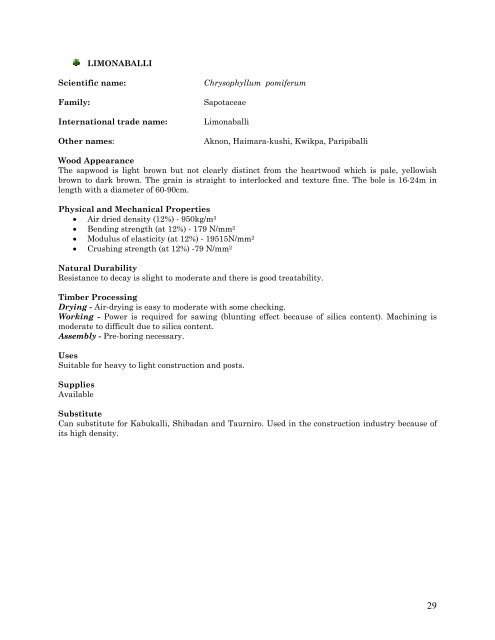21 Species Booklet 2004.pdf - Guyana Forestry Commission
21 Species Booklet 2004.pdf - Guyana Forestry Commission
21 Species Booklet 2004.pdf - Guyana Forestry Commission
You also want an ePaper? Increase the reach of your titles
YUMPU automatically turns print PDFs into web optimized ePapers that Google loves.
LIMONABALLI<br />
Scientific name: Chrysophyllum pomiferum<br />
Family: Sapotaceae<br />
International trade name: Limonaballi<br />
Other names: Aknon, Haimara-kushi, Kwikpa, Paripiballi<br />
Wood Appearance<br />
The sapwood is light brown but not clearly distinct from the heartwood which is pale, yellowish<br />
brown to dark brown. The grain is straight to interlocked and texture fine. The bole is 16-24m in<br />
length with a diameter of 60-90cm.<br />
Physical and Mechanical Properties<br />
• Air dried density (12%) - 950kg/m 3<br />
• Bending strength (at 12%) - 179 N/mm 2<br />
• Modulus of elasticity (at 12%) - 19515N/mm 2<br />
• Crushing strength (at 12%) -79 N/mm 2<br />
Natural Durability<br />
Resistance to decay is slight to moderate and there is good treatability.<br />
Timber Processing<br />
Drying - Air-drying is easy to moderate with some checking.<br />
Working - Power is required for sawing (blunting effect because of silica content). Machining is<br />
moderate to difficult due to silica content.<br />
Assembly - Pre-boring necessary.<br />
Uses<br />
Suitable for heavy to light construction and posts.<br />
Supplies<br />
Available<br />
Substitute<br />
Can substitute for Kabukalli, Shibadan and Taurniro. Used in the construction industry because of<br />
its high density.<br />
29


